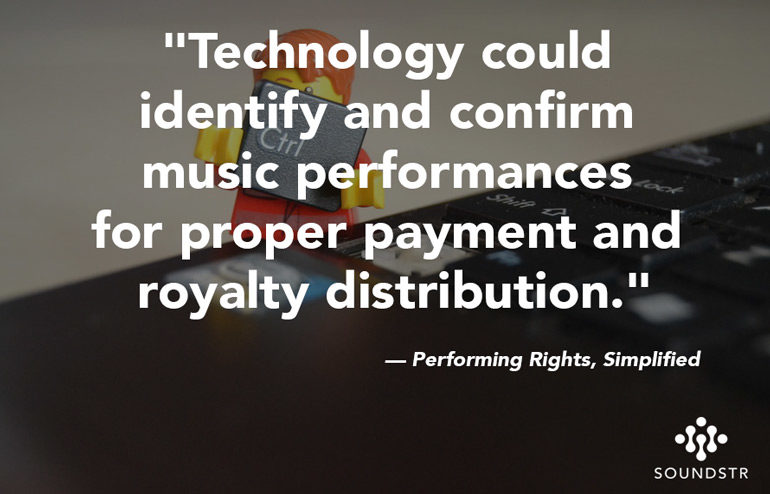For the final part of our series, “Performing Rights, Simplified,” we’re going to roll up our sleeves and get our hands dirty.
This series has focused on what performing rights are, methods of royalty collection and distribution, and the current climate of the industry. To be clear, we support performing rights. We believe that songwriters should be compensated when their music is used commercially. We also believe that businesses should only pay for the music they use. Our mission is to modernize the system by highlighting areas where transparency is needed. Creative thinking and technology solutions can make this a much fairer industry for everyone.
1. Old Industry
Consider how old this industry is. The performing rights industry is over 100 years old. ASCAP, the first US performing rights organization (“PRO”) opened in 1914, with SESAC in 1930, and BMI in 1939. The last major update to this industry was the Revised Copyright Act of 1976. The US Department of Justice has also weighed-in. ASCAP and BMI are governed by “Consent Decrees” via the US government which state additional rules by which these groups operate. These Consent Decrees are reviewed and updated every few years to make sure the PROs are keeping up with advancements in the industry (like technology).
2. Fast Action is Needed
Changes to the operation standards have been helpful, but are not happening quick enough to keep up with a modern world. 10-20 years is an eternity in technology terms. Think about how much the music industry has changed over the last 10 years: We’ve gone from CDs to file-sharing, to digital downloads to digital streaming and soon to Virtual Reality. More frequent updates to these Consent Decrees are needed to keep pace with technology and needed to increase transparency. Venues are still overpaying for general blanket licenses. The PROs are filing a growing number of lawsuits with businesses if they will not comply. (ASCAP fined a Cincinnati bar $90k for not paying fees). Artists are still not receiving fair compensation for their work within licensed businesses. Part 2 of this article shows that the more popular songwriters receive the majority of compensation from all performing rights fees. This is based on song weight/value, as it doesn’t take into account a song’s popularity within a specific medium (radio, TV, broadcast or live venue) of performing rights. This is a broken system, and we’ve reached critical mass.
3. Transparency & Accountability
If the main issue is transparency, how do we add a layer of accountability?
Look at the way music licensees collect and report data. Radio & TV submit data via several different ways, everything from manually written cue sheets to digital playlist submissions. The problem is verification. Playlist data only accounts for basic music performance. Manual cue sheets for TV is a different beast, as with any time there is room for human error. Yes, this allows for radio and TV businesses to pay “per segment” licenses for music they consume, as opposed to general blanket licenses. However, this still leaves room for verification. Technology could identify and confirm music performances for proper payment and royalty distribution. This could also simplify the process of determining how a performance is “weighed” and who to pay for a performance. (Hint: it’s not always who should be getting paid.)
The need for transparency and verification hits home even harder with businesses and venues. Without the reliable ways of tracking performances (see below), PROs charge music users a general blanket license for the ability to play all music in a catalog as opposed to pro-rated fees for only the music they use.
4. Technology is the Answer
How can we fix a broken system? The most immediate answer is technology.
Imagine a device that scans all live and recorded music. Businesses connect this device to soundboards, audio sources, and set top boxes. This device would generate usage reports that could verify music performances in all commercial settings. All businesses could shift from general blanket licenses to per segment payments for their actual music consumption. No more basic playlist submissions from radio stations. Handwritten cue sheets from TV stations would be a thing of the past. Businesses and venues would only pay for the music performed in their establishments. This leads to lower fees for music users and more compensation to songwriters and publishers. Yet, this means more money in the system. PROs would have a more accurate path to distribute funds to the appropriate songwriters and publishers. This would establish transparency, and the performing rights ecosystem would become more sustainable.
5. Soundstr Solution
Full disclaimer: this is exactly what Soundstr is doing. Our technology provides music use data, and we are currently working to both raise awareness of our efforts and get devices in the field. We are trying to offer a solution that helps songwriters, venues, businesses and ultimately the future of the music industry. Please join us in our movement.
Sign up for Soundstr’s recognition services for FREE at the link below. Discover where your music is used in the real world and start collecting the royalties you’ve earned.



July 27, 2016
[…] GMR, which are for-profit, are not bound by this agreement. (For a full history of the PROs, clickhere.) The Department of Justice reviews (and sometimes amends) the Consent Decree every few […]
July 27, 2016
Thank you for the repost!